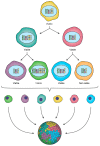Detecting Chromosome Instability in Cancer: Approaches to Resolve Cell-to-Cell Heterogeneity
- PMID: 30781398
- PMCID: PMC6406658
- DOI: 10.3390/cancers11020226
Detecting Chromosome Instability in Cancer: Approaches to Resolve Cell-to-Cell Heterogeneity
Abstract
Chromosome instability (CIN) is defined as an increased rate of chromosome gains and losses that manifests as cell-to-cell karyotypic heterogeneity and drives cancer initiation and evolution. Current research efforts are aimed at identifying the etiological origins of CIN, establishing its roles in cancer pathogenesis, understanding its implications for patient prognosis, and developing novel therapeutics that are capable of exploiting CIN. Thus, the ability to accurately identify and evaluate CIN is critical within both research and clinical settings. Here, we provide an overview of quantitative single cell approaches that evaluate and resolve cell-to-cell heterogeneity and CIN, and discuss considerations when selecting the most appropriate approach to suit both research and clinical contexts.
Keywords: cancer; chromosome instability; intratumoral heterogeneity; quantitative imaging microscopy; single cell approaches.
Conflict of interest statement
The authors declare no conflict of interest.
Figures




References
Publication types
Grants and funding
LinkOut - more resources
Full Text Sources
Other Literature Sources

